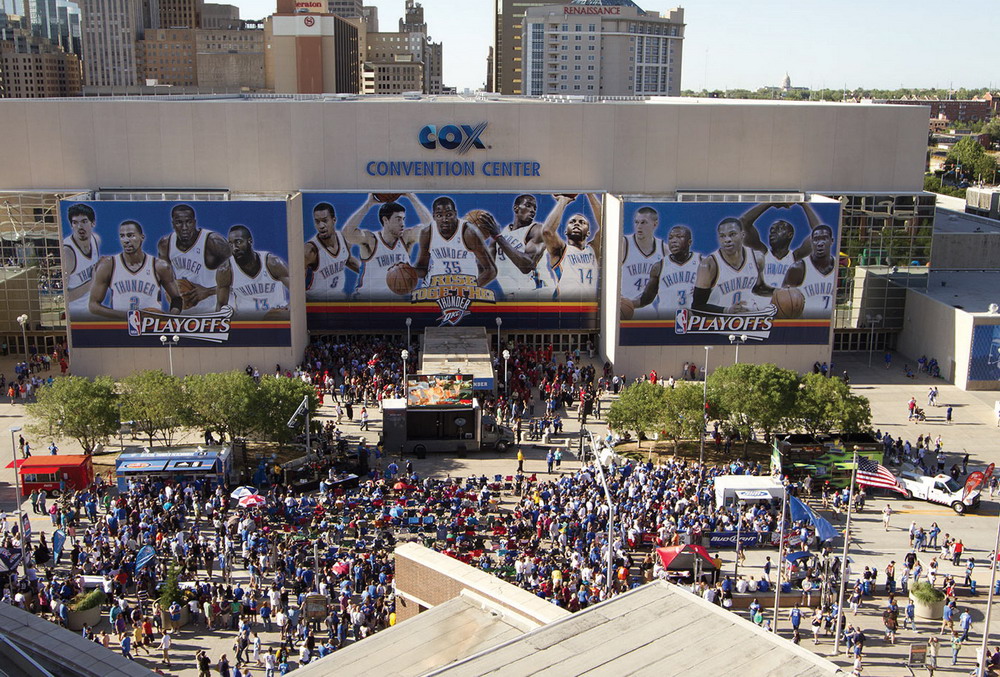People in Oklahoma love their sports. Seemingly everyone I encountered during a Memorial Day weekend visit to Oklahoma City wore University of Oklahoma Sooners regalia. However, since their move there in 2008 from Seattle, where they were known as the SuperSonics, the NBA’s Oklahoma City Thunder have quickly engendered a similarly passionate following as the only major-league sports franchise in the state.
To help Oklahoma City catch Thunder mania during the team’s recent improbable run to the conference finals of the NBA playoffs, team officials enlisted Metromedia Technologies (MMT), a NYC-based, digital-service provider with production facilities in Wooster, OH, and sales offices worldwide, to produce the program.
The job entailed wraps on the Cox Convention Center, which is across the street from The Ford Center, the Thunder’s home court; the SandRidge Energy building (the company’s president is also a minority owner of the Thunder); the Renaissance Tower; and the “skybridge” that connects the Oklahoma County courthouse with its adjoining annex building.
Paul Calce, MMT’s account executive who coordinated the project, had worked with the Thunder on previous wrap projects. He said, “Normally, when working with professional sports teams, we work directly for the club. This city is very passionate about its team, and they wanted to expand this year’s campaign. As the team made it deeper into the playoffs, the team ordered more wraps.”
MMT wrapped the Cox Center, which Calce said becomes one corridor of “Thunder Alley” on gamedays – where the team creates a tailgating-style experience with live radio broadcasts and promotional events — with images of the team’s players in action. It printed a series of narrow, mesh banners using MMT’s 9-oz., open-weave material; two measure 17.5 ft. x 169 ft. 8 in., and two more installed along the building’s sides measure 43 x 65 ft. The graphics for the Cox Center’s overhead canopy comprise 3M’s IJ 8624 rough-surface material. 3M’s 8519 luster-finish overlaminate protects the graphics.
For the sky bridge, MMT printed the 15.5 x 86-ft. graphic with 22, overlapping panels of Clear Focus Imaging perforated, self-adhesive material, which it topcoated with 3M 8518 glossy laminate. The installation crew completed the job in the wee hours one night while the road below was shut down.
Advertisement
To decorate the four concrete exterior walls of the SandRidge building, MMT fabricated four, 50 x 23-ft. wraps using 3M’s 3662 material – a media generally used for pedestrian graphics, but compatible for any porous, concrete surface because of its aggressive adhesive – that’s protected with the 8519 laminate.
Rather than overlaps, MMT installed the SandRidge applications with butt-seams because it made vertical alignment easier when installing 450 ft. above the ground. The Marriott building wrap, which covers one wall and spans 1,156 sq. ft., was also fabricated with the 3662 media.
As the namesake musical says, “wind whippin’ ’round the plains” is a ubiquitous part of Oklahoma’s weather. Calce said, “When the wind is swirling at 20 to 30 mph on the ground, it’s howling at 40 to 50 mph a few hundred feet above. We didn’t have a lot of days where we had to contend with extreme weather, but we had a few where we had to shut down installation for safety reasons.
When specifying materials for these conditions, you really have to think about wind load. For most of the sites, we used installation hardware already in place, although the mesh banners on the Cox Center called for a perimeter-tension system, which was custom-engineered with stainless-steel anchors and airplane cable.”
The “Let’s Go Thunder!” graphic arrived as an Adobe Illustrator vector file, and the player photos arrived as JPEG or Adobe® InDesign® files. The shop refined the graphics using its proprietary RIP. Calce said the development of its own RIP helped the shop earn G7 master-printer certification, a standard that affirms a provider’s proficiency with color synchronization from design through production.
For most applications, MMT implements a proprietary, drum-printing method. Calce said this provides better color density for grand-format work and UV stability. However, for this graphic, MMT used an EFI-VUTEk 3360 solvent-ink printer because ink adheres better than paint on perforated material. Using the paint process, MMT printed at 45 dpi; on the inkjet, it used 360 x 360 apparent dpi.
Advertisement



 Photo Gallery2 weeks ago
Photo Gallery2 weeks ago
 Ask Signs of the Times2 weeks ago
Ask Signs of the Times2 weeks ago
 Paula Fargo1 week ago
Paula Fargo1 week ago
 Real Deal5 days ago
Real Deal5 days ago
 Photo Gallery1 week ago
Photo Gallery1 week ago
 Women in Signs2 weeks ago
Women in Signs2 weeks ago
 Women in Signs2 weeks ago
Women in Signs2 weeks ago
 Projects5 days ago
Projects5 days ago









